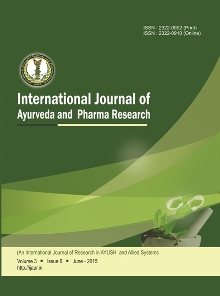An Observational Study to Establish A Correlation Between the Signs and Symptoms of Kurchashir Marma Viddha of Upper Limb and De Quervain’s Disease
Abstract
Aim: This study aims to establish a correlation between the signs and symptoms of Kurchashir Marma viddha of upper limb and De Quervain’s disease through a detailed observational study. Materials and Methods: An observational study was conducted involving 30 patients diagnosed with De Quervain’s disease, confirmed using Finkelstein’s test. Patients were assessed for various signs and symptoms associated with both Kurchashir Marma viddha of upper limb and De Quervain’s disease. Results: The findings revealed that over 75% of patients with a positive Finkelstein's test exhibited symptoms such as Aghataj Hetu (excess work), duration, Ruja (pain), Shoph (swelling), Sparshasahatva (tenderness), and Visual Analog Scale (VAS) scores. Additionally, more than 50% of patients reported symptoms related to fine work. Demographic analysis indicated that the majority of patients were aged between 20-40 years, with a higher incidence in males (53.3%). The study also found that 96.7% of patients had a history of excess work, and 76.7% presented with swelling over the thumb. Conclusion: The anatomical structures involved in De Quervain’s disease correlate with those of Kurchashir Marma. The symptomatology of Kurchashir Marma viddha of upper limb aligns closely with that of De Quervain’s disease, suggesting that the signs and symptoms of both conditions are similar. This study highlights the potential for integrating traditional Ayurvedic concepts with contemporary medical diagnoses to enhance understanding and management of these conditions.
Copyright (c) 2025 International Journal of Ayurveda and Pharma Research

This work is licensed under a Creative Commons Attribution-NonCommercial-ShareAlike 4.0 International License.


